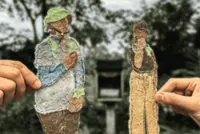As the Lungwevungu River gets wider, the rapids get stronger and Kerllen Costa has to find the navigable lines to pass safely through.
Rolex, through its Perpetual Planet Initiative, is supporting a ground-breaking scientific initiative that explores the uncharted territories of Africa’s great rivers, the Great Spine of Africa series of expeditions, in collaboration with Steve Boyes, a prominent South African ornithologist and conservation biologist.
Boyes has dedicated his life to preserving Africa’s great wildernesses and the species that depend on them. A partner of the Rolex Perpetual Planet Initiative, Boyes is the Chairman of the Wild Bird Trust, a National Geographic Explorer and Senior TED Fellow.





